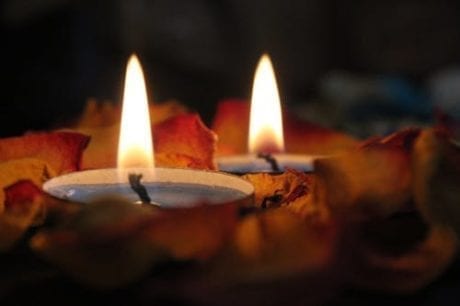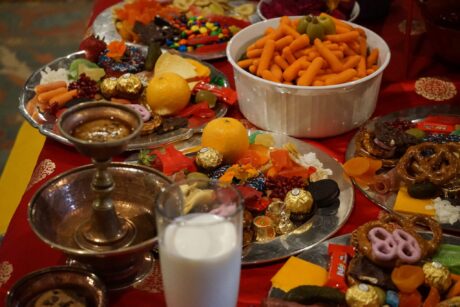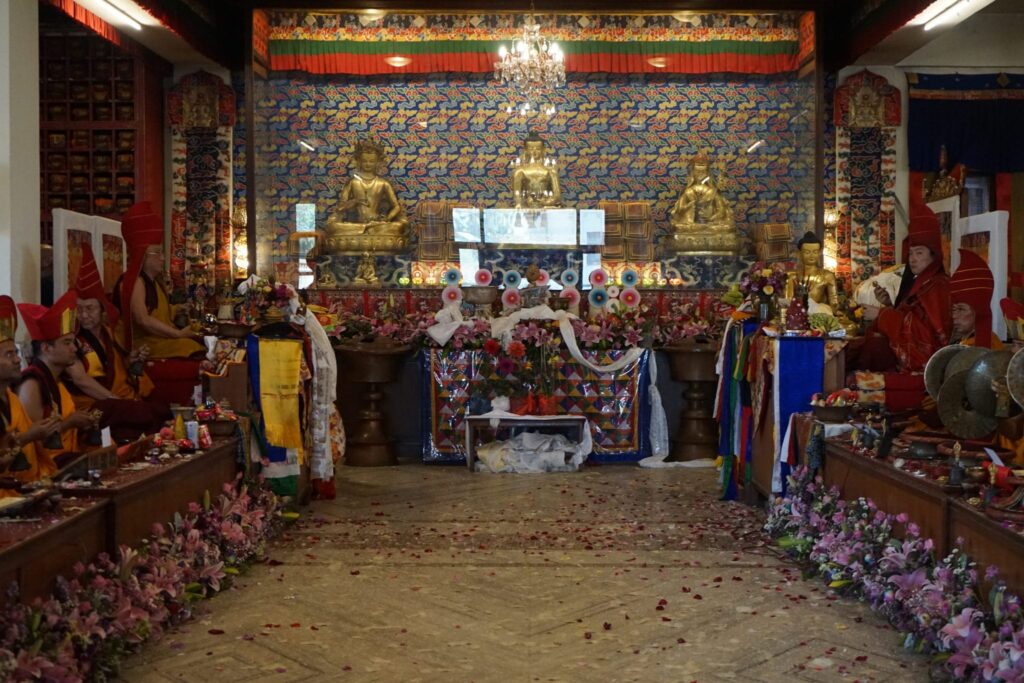What is Ritual? I’m Only Here For the Meditation
Kyabgön Phakchok Rinpoche teaches and travels widely throughout the world. On his tours, he often encounters modern people who are highly skeptical about ritual practice. Those of us who are academically educated have developed the pattern of seeing ritual practice as common superstition. Phakchok Rinpoche delights in challenging us by asking us to see how close-minded this attitude may be. You may personally have doubts about ritual or not know how to express some of the reasons behind its aspects to your friends and family.
We ask you to take some time right now to reflect on your own motivation to practice meditation. Many of us became interested in Buddhism because we were stressed or anxious, or felt something was not quite right with our life direction. Some of us may have taken up meditation because we’ve heard it offers a lot of benefits. Others may have been interested in finding answers to metaphysical questions.
Mindfulness and meditation practice, with their physical and mental benefits, are a popular topic these days. Doctors, therapists, schools, physical trainers and employers are all touting the benefits of meditation. Mindfulness (awareness of one’s environment and mental state) has been the main secular approach offered in the west. Having read research on the benefits, we may have become interested in being more mindful. All of this is very positive. And it shows that we are actually quite intelligent–we are seeking answers. The world can benefit from more mindful and kind people. The growing attention to the benefits of living a mindful life are certainly cause for celebration.
Motivation and Mindfulness
Yet, Phakchok Rinpoche often reminds us that if we are interested in or have decided to follow the Buddhist path, we should be aiming for more than just calmness and mindfulness. Our true goal is cultivating wisdom and compassion for the benefit of ourselves and all others. That does not mean that we need to discount the side benefits of meditation and mindfulness practices. In fact, throughout the history of Buddhism teachers speak of both mundane and ultimate benefits. There’s nothing bad about developing a healthier body and mind as we train on the path. Short term transformation is a great side benefit–it is just not our real aim.
When we focus only on mindfulness and silent or sitting meditation sessions focused on our breath, we may be missing out on positive changes to our daily lives that can come about with other practices, commonly referred to as rituals. There is vast array of meditation techniques that enhance our experience of mindful awareness. These techniques include compassion meditation (tonglen), visualization exercises, mind training (lojong), and prayer, as well as rituals. Research into the benefits of these other aspects of Buddhist practice is a fairly new field of study. Promising results have been shown in such areas, and neuroscientists, psychologists and long-term meditators are forging important partnerships to explore the mental and physical benefits of these other elements of Buddhist practice. In the various topics we discuss below, we will highlight just a few of the interesting observations arising in such studies.
Ritual Helps to Prepare the Ground
From a historical perspective, we should understand that the Buddha usually taught extensively on topics of mind training, like generosity, and rituals, like making offerings, before teaching people to meditate. His teachings contain lots of advice on proper conduct, and how to interact with others. If we skip over these teachings, thinking that all we need is the meditation training, we are missing a vital preparatory phase to include our relationships and tame our mind. Teachers often use the metaphor of planting a crop in a well-tilled field.
We need to prepare our own “ground” for meditation to come easily.
With ritual practice we tame our minds as we carefully carry out particular physical and verbal actions. This form of mind training is itself meditation practice, although it is rarely presented in those specific words. As we bring mindfulness to our physical, verbal and mental actions, we can remain more fully present in that state throughout our activities. Ritual, rather than binding us to old-fashioned customs, is a way to express our values and truths in a joyful and dynamic way.
What is Ritual? Adding Some Grease!
Rinpoche often teaches that ritual practice, properly applied, helps us to open the rusty hinges of our tight views. We need to add some grease, he advises!

Engaging in ritual practice greases our practice by introducing flexibility and possibility into our usual way of thinking of and interacting with the world. Rinpoche uses the word “greasy” also to express the quality of richness, or flavor, that marks an excellent Buddhist practitioner.
We can think of ritual as the oil that adds taste and deliciousness to a good meal. He observes that many people who practice for years intensively, but who avoid ritual, often resemble a dry and tasteless dish. While we may know a lot about Buddhism, we may be missing opportunities to enrich and transform our lives.
When we leave our practice thin and dry, we might get discouraged with our lack of progress and simply stop practicing. Or, we might practice on and off, starting and stopping and never really making any progress. Unfortunately this happens often because we are so busy and distracted that we are always chasing after some new fix for our lives. Alternatively, we might develop a puffed-up pride in our ability to sit for hours in solitary meditation, and then develop a condescending attitude toward others. All of these are undesirable outcomes that we need to watch for in our own practice. Instead we can become greasy practitioners who stay motivated and humble through ritual activity. We can then remain joyous on our journey and we can be inspiring to others.
What is Ritual? Cross-Training!
It may also be helpful to think of the skillful means of ritual practice as a form of cross-training.

In the past several decades, even casual athletes have begun to add different forms of physical training to their workouts. Runners have begun doing yoga and lifting weights, and bikers and swimmers alternate activities. In sports, a good coach will work with an athlete to develop a well-rounded training program to avoid boredom, reduce the risk of injury, add new challenges, and balance muscle groups. In the same way, when we do ritual activity, we are still practicing mind training. This is an important point to reiterate: All ritual practices are forms of mind-training and types of meditation. A teacher suggests certain practices based upon the inclinations of individual students, and helps them to develop their full potential. Some practices are suitable for almost all students, and others may meet more specific needs.
What is Ritual and What Does it Bring to Buddhist Practice?
“Ritual is just superstition and custom and I don’t do ritual!”
This is a common refrain in our busy, secular world. Some of us may have rejected prior belief systems that we found too structured. Others of us may have been raised in a secular environment where religious ritual was seen as ignorant superstition. For now, simply try to keep an open mind and consider a few questions.
What is Ritual Really?
Phakchok Rinpoche often teases us about our attitude expressed in the quote above by pointing out its inconsistency with our behavior. He uses the example of a dinner date.

Would you, he asks, invite a date out for a special dinner and not behave in certain customs? And wouldn’t the date generally go better if you spoke kindly and lovingly to your partner? Would she or he appreciate your having dressed up a bit for the occasion, or perhaps offered some flowers, or wine?
When we consider our lives carefully, we generally admit that we spend a fair amount of time engaging in rituals. We do it in our families when we celebrate birthdays and anniversaries, and gather together for celebrations. Our schools highlight commemorations and graduation ceremonies. Sports events are full of ritual behavior. We celebrate when our team wins, we wear special colors, and carry flags and offer parades. At work, we may celebrate hump day or TGIF with colleagues by heading to the local bar after office hours. You may have a special bed-time ritual for you and your kids–like reading them a favorite story or having a cup of cocoa.
We cut ribbons to open new places of business, and crack champagne bottles over new boats or vehicles. Our countries celebrate national holidays with a wide variety of ritual behavior which include inspiring concepts and the various sensations, sights, sound etc. Some of us may engage in these activities more wholeheartedly than others, but it would be a real challenge to find someone who totally avoided ritual.
Reflection on Rituals
Now take a few minutes to think about the rituals you value. What do they involve? Are you alone or with friends and family? Do you think of special foods, or decorations, or smells, or visual images? Is there music or movement involved? Really spend some time to consider these points. What about these practices brings meaning for you? Are there particular senses that mark something as special?
What About Religious Ritual? Why Should I Waste My Time Learning This?
When it comes to spiritual practice, some of us draw a very firm line. This is one area where we claim we don’t want to introduce ritual. Now, if you have taken the few moments to reflect that we suggested above, you might pause here–why does this seem to be different? We might say that spiritual ritual is performative. The participants “do something”–we perform activity using our body, our speech and our minds. Buddhist teaching explains that we have five sense doors–our eyes, ears, nose, mouth, and touch plus the mental processes as well. Ritual activity may involve all or some of these.
It is important to consider that ritual engages other centers of our being besides our busily thinking minds. This may be particularly important for us stressed modern people. We operate so much of the time with our analytical minds. True centeredness includes the experiences of the body. When we engage in spiritual ritual actions, we usually direct some physical action to an object, a site, a person, that we believe has sacred power or represents certain fundamental truths. But we’re not only thinking about this–we’re actively engaging our other senses to more fully connect.
Ritual Engages Different Learning Methods
These days researchers and educators often speak about different learning methods. We know that some people are visual learners, some are more kinesthetic (movement) oriented, while others may be verbal. And many of us learn most effectively by using multiple learning styles. They reinforce each other and help us to internalize important messages. We may come to deeper insights into the teachings and truths by using multiple learning methods. As intelligent beings, we can acknowledge the truth of experiential learning–many educators now advocate this more active learning method. And this style of learning is not culturally specific or new.

So we might consider the possibility that it might make more of an impact on us to offer lamps representing wisdom to a statue of the Buddha than to sit by ourselves reading about the great qualities of developing that trait. Perhaps the smell of incense and the beauty of flower offerings will trigger a new response in our minds. There is a reason that human beings throughout history and across many cultures have turned to these types of physical practices.

We value flowers and lights as important props for many special events, don’t we? If we’re setting a dinner table for a romantic evening, we’d often add candles and beautiful flowers to add an extra element of beauty and to create a special atmosphere. And we can observe our own reaction to seeing such a presentation–our senses are delighted and it feels somewhat special, doesn’t it?
Similarly, when we set up a Buddhist shrine, we are taking the time and putting in the effort to create a special and supportive environment for practice. Of course, we could practice meditation anywhere–even on the toilet, as Rinpoche often reminds us. But, until we are more stable in our practice, careful attention to the setting can offer us more doorways into the practice.
Ritual: The Art of Doing
Traditionally we approach the Buddhist teachings with a comprehensive program of study, reflection and meditation. Yet, we must be realistic about our own ability to commit intensive amounts of time to this type of practice. We might also recognize how our busy modern lives have led us to favor catchy slogans and photos instead of long texts. After all, this is the age of the emoticon and the GIF.
We may be intellectually sharp and able to absorb intense philosophical study but many people simply don’t have time to dedicate to that type of practice. Ritual practice offers us an alternative to internalize important lessons by doing rather than only by reading and reflecting. As we make offerings, or do prostrations, circumambulations, or visit sacred sites, if we approach these activities with open minds and hearts, we can “do” dharma throughout our days in simple, but very profound ways.
Ritual: Assembling All the Conditions
The Buddha also taught that all things arise from causes and conditions. We can read all the examples of how that works in the outer world–such as a sprout arising from a seed. In that context, we need good soil, water, fertilizer, sunshine, proper weather, care and time. Similarly, if we want to practice Buddhism, we are much more likely to develop into strong, healthy practitioners if we assemble all the helpful conditions. Thus, when we are open to the possibilities of ritual practice, we are able to soften our minds and hearts by taking part in these physical activities. And with curious and open hearts, we allow for wisdom and compassion to naturally arise within our mindstreams.
Samye Instructor










Responses